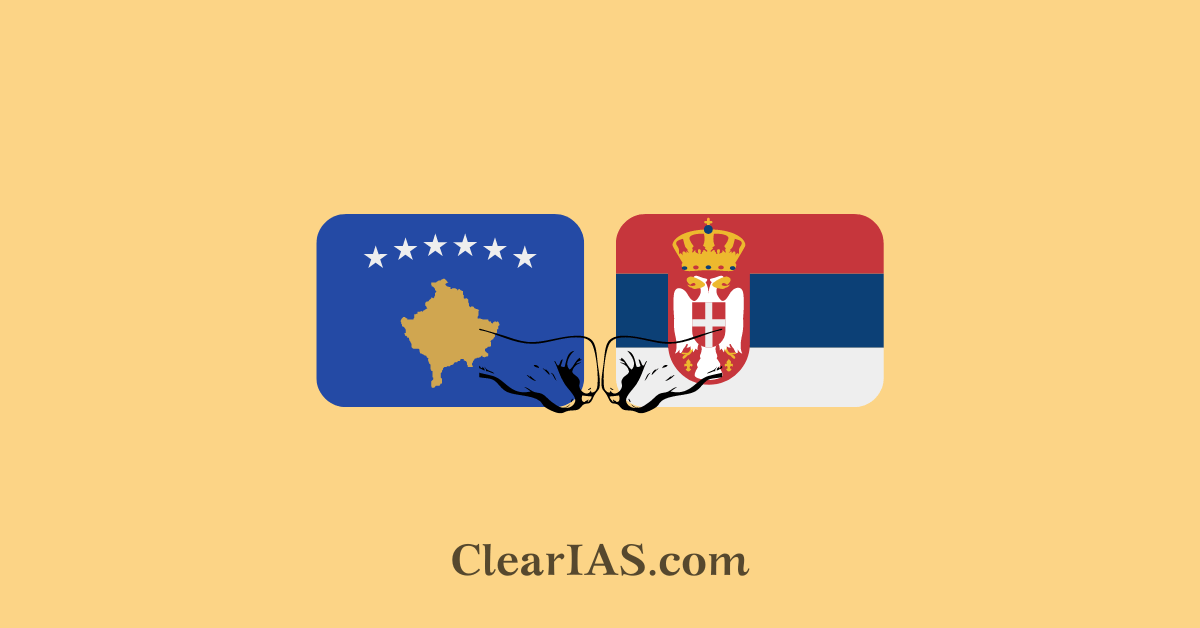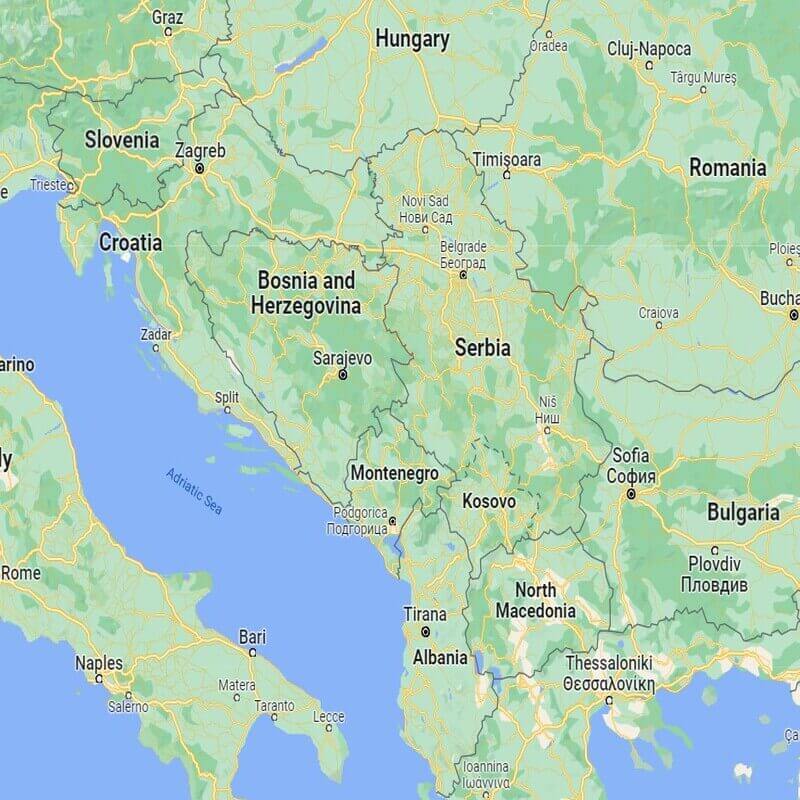
The Kosovo-Serbia Conflict is over two decades old and keeps flaring up now and then. Almost ten years after a guerrilla struggle, Kosovo gained independence from Serbia in 2008. However, Serbia continues to view Kosovo as a fundamental part of its territory and denies stirring up tensions and strife within its neighbor’s boundaries. Read here to know more about the history.
Kosovo is a tiny, landlocked nation in the Balkans that borders Montenegro, Serbia, North Macedonia, and Albania. It is regarded as the birthplace of the Serb people by many. However, 92% of the 1.8 million people that call Kosovo home are Muslim Albanians, whereas only 6% are Serbian. Bosniaks, Gorans, Turks, and Roma make up the remainder.
Serbia is a country in the west-central Balkans. For most of the 20th century, it was a part of Yugoslavia, which included the modern countries of Serbia, Croatia, Slovenia, Bosnia and Herzegovina, Kosovo, North Macedonia, and Montenegro.
The Kosovo-Serbia relations and history date back to when they were part of Yugoslavia after the disintegration of the Ottoman empire.
Breakup of Yugoslavia

Immediately following World War I, the states of Slovenes, Croats, Serbs, and the Kingdom of Serbia were united to establish the new country in 1918.
- These constituent countries, which had previously alternately been ruled by the Ottoman Empire and Austria-Hungary, came together in 1918 to form an independent federation known as the Kingdom of Serbs, Croats, and Slovenes.
Yugoslavia was first used in an official capacity in 1929 after the government later changed the country’s name.
- The concept of Yugoslavia, as a single state for all South Slavic peoples, emerged in the late 17th century and gained prominence through the Illyrian Movement of the 19th century.
In the Kingdom of Yugoslavia, World War II broke out in 1941, when Axis forces swiftly overran the nation and divided it among Germany, Italy, Hungary, Bulgaria, and their client regimes.
- Yugoslav post-war casualties were huge as it was caught in the middle of the whole war and ethnic war within as well.
After the war, in 1946 the Federal Republic of Yugoslavia was established and modeled on the constitution of the Soviet Union. The federal capital was Belgrade.
- The Socialist Republic of Serbia and the socialist autonomous province of Kosovo were part of the new federation.
By 1948, Yugoslavia distanced itself from the Soviet Union and started its brand of socialism under Josip Broz Tito.
- The socialist political philosophy called Titoism rose during the cold war period.
- It is characterized by a broad Yugoslav identity, workers’ self-management, political separation from the Soviet Union, and leadership in the Non-Aligned Movement.
In 1963, the nation was renamed the Socialist Federal Republic of Yugoslavia with Tito as President for life.
- The ethnic tensions and economic crisis raked the country for a long duration after this.
After Tito’s death on 4 May 1980, ethnic tensions grew in Yugoslavia.
- The Albanian majority in Kosovo demanded the status of a republic in the 1981 protests in Kosovo while Serbian authorities suppressed this sentiment and proceeded to reduce the province’s autonomy.
The Yugoslav wars started amid protests among the different Republics and autonomous provinces.
- In 1991, Slovenia and Croatia became the first republics to declare independence from Yugoslavia.
- Later in 1991, the Republic of Macedonia also declared independence and gained sovereignty without resistance from Belgrade.
- In 1992, Bosnia and Herzegovina’s independence was recognized by the US and other European states.
- In 1992, Serbia and Montenegro formed the Federal Republic of Yugoslavia.
- In 2006, Montenegro became an independent nation after a referendum, leaving Serbia as the successor of FR Yugoslavia.
- In February 2008, the Republic of Kosovo declared independence from Serbia, leading to an ongoing dispute on whether Kosovo is a legally recognized state.
Yugoslavia finally broke down into seven independent nations namely-
- Bosnia and Herzegovina (Capital: Sarajevo)
- Croatia (Capital: Zagreb)
- Kosovo (Capital: Pristina)
- Montenegro (Capital: Podgorica)
- North Macedonia (Capital: Skopje)
- Serbia (Capital: Belgrade)
- Slovenia (Capital: Ljubljana)
Kosovo-Serbia Conflict
The Kosovo War was an armed war that took place in Kosovo from 28 February 1998 to 11 June 1999. The forces of the Federal Republic of Yugoslavia, or Serbia and Montenegro, which had previously governed Kosovo, engaged in it.
Albanian-majority Kosovo declared independence with the backing of the West, following a 1998-99 war in which NATO intervened to protect ethnic Albanians.
Around 50,000 ethnic Serbs living in northern Kosovo refuse to recognize the government in Pristina or the status of Kosovo as a separate country. They have the support of many Serbs in Serbia and its government.
The modern Albanian-Serbian conflict has its roots in the expulsion of Albanians in 1877-1878 from areas that were incorporated into the Principality of Serbia.
- Expelled Albanians settled in Kosovo and between 1876 and 1878 there were attacks on and in 1901 massacres of Kosovan Serbs.
- Tensions between the Serbian and Albanian communities in Kosovo simmered throughout the 20th century and occasionally erupted into major violence, particularly during the First Balkan War (1912-13), World War I (1914-18), and World War II (1939-45).
Current status of the conflict
Serbs in Kosovo want to create an association of majority-Serb municipalities that would operate with greater autonomy. Serbia and Kosovo have made little progress on this and other issues since committing in 2013 to the EU-sponsored dialogue.
Since 2022 fresh ethnic tension has flared up between Kosovo-Serbia. The Serbs have been putting up roadblocks and Belgrade had increased armed presence on the border.
Global response to Kosovo-Serbia Conflict
Kosovo has been a source of tension between the West, which supported its independence, and Russia for more than 20 years.
Russia backs Serbia in its attempts to prevent Kosovo from joining international organizations like the UN.
- NATO has about 3,700 troops stationed in Kosovo to maintain the peace. The alliance said it would intervene in line with its mandate if stability in the area were jeopardized.
- The European Union Rule of Law Mission in Kosovo (EULEX), which arrived in 2008, still has around 200 special police officers there.
The European Union and the United States are concerned about the continued tense situation in the north of Kosovo.
Over 100 countries like the US, France, and Germany have recognized the Republic of Kosovo and established diplomatic relations.
Indian stand on the Kosovo-Serbia issue
India has been on the side of Serbia in the Kosovo-Serbia Conflict.Severalf countries, including Mexico, Brazil, China, India, and Brazil, do not recognize Kosovo.
India has insisted that UNSC Resolution 1244, which intended to create an “interim government for Kosovo” to resolve the political turmoil there at the time, conflicts with Kosovo’s proclamation of independence.
- This goes back to the fact that Jawaharlal Nehru and then Yugoslavian President Tito were founders of the Non-aligned movement.
- Belgrade, the capital of Serbia, was the host of the First Summit of the Non-Aligned Movement in September 1961.
Since Yugoslavia’s dissolution, India and Serbia have developed closer connections. The increased flow of individuals between the two countries is one example of this.
Indian people are no longer required to obtain visas for stays of up to 30 days in Serbia since 2017, which significantly increased the number of Indian tourists that travel there.
But India and Kosovo share a trade body known as India-Kosovo Trade Commerce Economic Office (IKCEO) inaugurated in November 2022.
- IKCEO is a trade association, independent of the government, formed by business people in Kosovo and those in India.
- The basic idea is to find common ground and let some business roots open, especially for sectors like agriculture, energy, and tourism.
Also read: Disintegration of the USSR (1991): Reasons and Impact
-Article written by Swathi Satish






Leave a Reply